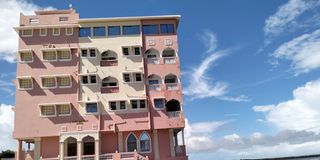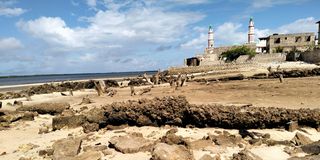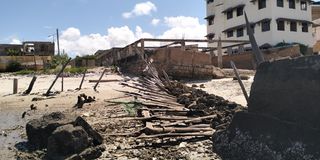Nature fights back against reckless scramble for Lamu’s beach plots

A newly constructed hotel that directly borders the Indian Ocean in Wiyoni, Lamu on May 18, 2025.
What you need to know:
- Lamu County, with its pristine beaches and rich marine ecosystems, is facing an environmental crisis as uncontrolled coastal development collides with natural forces and regulatory failures.
Walking along Wiyoni beach in Lamu, visitors encounter a troubling sight: building blocks, marbles and structural metals scattered across the sand—remnants of construction projects that were built within the shores only to be washed away by the ocean. In some areas, buildings stand partially submerged in the Indian Ocean, creating a surreal landscape that speaks to a deeper crisis.
This destruction isn't caused by unusual tides, rising sea levels or extreme weather events, rather by developers who have flagrantly ignored laws designed to protect Kenya's fragile shoreline riparian zones.

Building materials that were washed away by Indian Ocean waters in Wiyoni, Lamu.
Lamu County, with its 130-kilometer coastline and over 65 islands forming the Lamu Archipelago, represents Kenya's smallest county by population but one of its most environmentally sensitive areas. The county is home to two national reserves: Dodori and Kiunga Marine, covering 877 square kilometres, and its extensive mangrove forests serve as nurseries for many marine species, acting as breeding grounds for fish, crustaceans, and mollusks while contributing to carbon sequestration, water purification, and coastal protection.
Despite this ecological importance, Kenya's four marine parks and six marine reserves cover approximately 0.67 per cent of Kenya's Exclusive Economic Zone, highlighting the limited protection afforded to the country's marine resources. The legal framework requires all coastal developments to observe a 60-metre setback line from the shoreline, but enforcement remains problematic.

A fence that was partly washed away along the shoreline in Wiyoni, Lamu.
Shoreline riparian zone protection laws aim to conserve the valuable ecosystem between land and water bodies by restricting development within specific areas. These regulations protect water quality, maintain critical habitat, and preserve recreational opportunities that support local economies.
Now, environmentalists in Lamu County are increasingly concerned about residents and private developers who flout shoreline protection laws in their quest to secure land for development. In places like Wiyoni, developers are literally fighting nature, risking lives and investments to claim coastal land.
Speaking to Climate Action, Lamu Voice of the Ocean Organisation Spokesperson Ahmed Salim expressed concern over the significant dangers posed by irresponsible coastal development to both marine life and human populations.
"When strolling in places like Wiyoni beach, it's pathetic seeing broken construction materials along the ocean. These materials and runoff are already polluting the ocean environment and marine life," said Mr Salim.
Mr Salim noted that continued establishment of structures along shorelines without considering the 60-metre setback requirement could result in disruption of natural habitats, reduced marine ecosystem biodiversity, and widespread environmental contamination. He questioned why such developments proceed freely under both national and county government oversight, accusing the National Environment Management Authority (Nema) and devolved government of "sleeping on the job."
For coastal communities, these irresponsible developments contribute to increased flooding risks, erosion and other hazards that Lamu archipelago residents witness regularly. "How can you be silent and let irresponsible developments be undertaken along our shorelines? By letting this happen, it directly means you're exposing the Lamu communities, making them more vulnerable to natural disasters and even threatening lives and property. This should be stopped forthwith," said Mr Salim.
Regulatory confusion and enforcement gaps
Edward Menza, the Lamu County Nema director, explained that under Wetland Regulations 2009, any development affecting seashores or wetlands must undergo Environmental Impact Assessment (EIA). However, there appears to be confusion about setback requirements.
Mr Menza stated that the setback limit is 30 metres measured from the highest recorded flood or tide level, below which is considered part of the sea. However, he acknowledged that the Survey Act sets the setback limit at 60 metres from the highest recorded flood or tide level.
"As it stands now, being the current office bearer, I can work on anything coming up and not the completed developments. However as per the law, Nema cannot cancel its own licence for the completed developments," said Mr Menza.
He advised that aggrieved parties could petition the National Environment Tribunal under section 129 of the Environment Management and Coordination Act (EMCA), which might result in canceled Nema licences, environmental integrity measures, or maintaining the status quo.
Mr Menza emphasised that encroaching on riparian reserves not only degrades environment and habitats but also endangers lives. "Besides being part of fish breeding sites, the riparian reserve also protects us against extreme flooding from climate change surges in sea waters, resulting from other extreme weather events. It may take time but the environment can be very unforgiving if we degrade it," he said.
Lamu County Environment and Climate Change Chief Officer Mohamed Dirie acknowledged that coastal development must comply with EMCA, conduct EIA, obtain planning approvals from both national and county governments, and consider sectoral laws depending on location—whether within wetlands, mangroves or marine parks. However, he provided no explanation for why irresponsible developments continue under their oversight.
A senior county government official, requesting anonymity due to the matter's sensitivity, revealed that most high-rise buildings and structures along county shorelines received approvals from the defunct Lamu County Council long ago. "Our hands are tied. We can't stop those developers since they have genuine licences approved a long time ago by the defunct county council. You can't stop someone from developing their own lands and they have approvals. The matter is complicated," the official said.
Ali Omar, a resident and private developer on Lamu Island, argued that Wiyoni shoreline represents a unique case. "Yes. We're carrying out developments even inside the Indian Ocean and we're not deterred because for some of us, the approvals given show that our lands are part of the ocean. What can we do? Wiyoni shoreline case is very unique and you need to understand the history first, which has also contributed to the current status of this area. You'll get a different perspective," said Mr Omar.
The creation of Wiyoni: A historical perspective
Alex Jimbi, Lamu chief officer for Roads, Transport, Infrastructure and Public Works, provided crucial historical context that explains the current crisis. He admitted that it's unfortunate to see developments in shorelines that can cause serious problems, but explained Wiyoni's unique origins.
Wiyoni was once a mangrove swampy area. In the 1990s, the Kenya Ports Authority (KPA) dredged the Mkanda Channel to deepen it, allowing boats traveling to Lamu East Sub-County to maneuver during both high and low tides. The dredged sand sediment was deposited at Wiyoni, which was previously part of the Indian Ocean, effectively creating new land.
Mr Jimbi insisted that Wiyoni consists of sand-filled, unstable terrain unsuitable for uncontrolled, unplanned high-rise development. This raises questions about whether developers were misled into purchasing land inappropriate for construction.
"In fact, the land should have been earmarked to form open space, beach or recreational space due to scarcity of open land. The rebirthed land at Wiyoni, after completion of the Mkanda Channel dredging project, was left to Lamu people. Eventually, people started to move in, grabbing spaces and securing the space in an uncontrolled and unplanned manner," said Mr Jimbi.
Due to lack of enforcement intervention and proper planning, the area was developed to accommodate squatters without involving stakeholders and planners who could have provided better guidance on appropriate land use for such fragile terrain.
"Today, the area is fully developed but so many challenges are now cropping up. For those who built up to the high water mark without considering the type of foundations or materials, most of these buildings already show major structural failure. Some of the foundations are exposed, posing danger to the housing and putting risks to those staying in these houses," said Mr Jimbi.
The architectural expert highlighted additional dangers, including the lack of proper sewer systems. Everyone building in Wiyoni digs septic tanks that don't exceed two metres depth. "That means going past the water table or level. So, each and every house septic tank will eventually make the land unstable since the underneath is still part of the ocean," he explained.
The path forward
Mr Jimbi suggested implementing regulations for controlled, standardised designs to mitigate current risks. However, with existing developments already compromised and new construction continuing, the challenge of balancing development needs with environmental protection remains daunting.
The situation is further complicated by the Lamu Port South Sudan-Ethiopia Transport Corridor project, which is projected to serve over 160 million people in East Africa when fully operational, potentially attracting massive migration to the area.
The Wiyoni situation exemplifies broader challenges facing Kenya's coastal management. Kenya's marine environment faces numerous threats from a growing coastal human population estimated at just under three million in 2000, with extraction of fish and other resources from narrow continental shelf, coral reef and mangrove ecosystems increasing each year with inadequate monitoring and management structures.
As Lamu continues to grapple with balancing development pressures against environmental protection, the case of Wiyoni beach serves as a stark reminder of what happens when legal frameworks fail to keep pace with development pressures, and when enforcement mechanisms prove inadequate to protect some of Kenya's most precious coastal resources.


